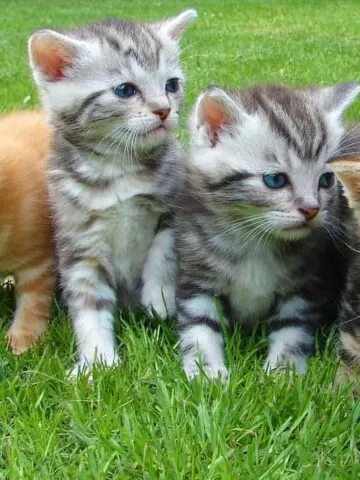Have you ever seen your cat bob its head from left to right or up and down?
Your cat can bob their heads for a variety of reasons, and some of these reasons are not obvious. Head bobbing may seem a bit strange, but it is sometimes important.
Cats bob their heads for many reasons, ranging from nothing to worry about to needing immediate attention.
Sometimes cats bob their heads because they’re watching an object, measuring a jump, or maybe reacting to something.
However, in some instances, your cat’s head bob may be due to an ear infection, vestibular imbalance, or head injury.
If your cat has a sudden head bob, you understandably look for anything that could be causing it. It is human nature to look for common reasons for your cat’s unusual behavior and find a solution.
There are several possible ideas, while other reasons for head bobbing remain a mystery; time to check out the possibilities.
Why Does My Cat Bob Their Head?
It’s a frequent occurrence that your cat may try to get your attention, and head bobbing is an attention grabber. If you see your cat bob their head, it is sure to make you question and investigate.
Bobbing draws your attention to your cat, much like shaking their paws, which is precisely what they want.
Bobbing is sometimes just out of habit as they wait for food, but it is often an important habit. It is used for stalking your feet and just for their entertainment.
In observing your cat, you can see if the head bobbing is for fun or serious conditions.
Keeping A Watchful Eye
Cats are naturally curious, and often they are constantly watching what is around them. If your cat spots something that is of interest, you may see an intense stare.
From watching a mouse to even something as small as a fly, your cat will keep an eye on it.
In watching something like a bug or a fly, you may see your cat bob their head in all directions. This action allows your cat to follow the fly and also keep a vigilant eye on its surroundings.
Bobbing their head is a step in the ability to stalk and patrol their target.
It is in your cat’s DNA to hunt and stalk their prey. They can use all their senses to track and attack from numerous angles. The head bob allows them to keep a watchful eye on their target and protect themselves.
The Measure Of A Jump
You may see your cat take the all too familiar bum-in-the-air stance before they take a jump. You may also see your cat moving and bobbing their head in such a way it looks strange.
This is a tactic they use to gauge their jump ahead of time.
Your cat is not tall but can jump to great heights, and to do the jump; they have to look ahead. In other words, they literally have to look before they leap.
So you may see that characteristic head bob as they gauge the length and height of their target.
Jumping to and from a high surface takes precision, and your cat wants to make sure they can clear it. A cat’s perfect eyesight and head bobbing allow them to clear the distance without any problems.
Reaction Time
Cats, though stealthy, also like to get attention sometimes. If they are not rubbing against you, they are trying to get your attention in some way. They also do this to something they may be chasing.
Cats love the thrill of the chase but sometimes being stealthy is too easy. They may bob their head to get the attention of something they are stalking.
It is often to draw attention to themselves, and the way their prey reacts gives them a better chase.
Sometimes it is not always about if they get their prey, but if it was fun or challenging enough. So if your cat is outside bobbing their head, they might be trying to add some excitement to their hunt.
What Are Some More Serious Reasons For My Cat’s Head Bobbing?
While most reasons for your cat’s head bobbing are simple explanations that require little worry, some are more serious.
If your cat bobs their head for one of the following reasons, you’ll likely want to schedule a vet visit ASAP.
Ear Infections
The most common form of head-bobbing is possibly ear issues. From ear mites to yeast infections to just plain dirt, ear problems can cause your cat problems and discomfort.
These issues or something as simple as built-up earwax can cause your cat to bob their head.
The bobbing may be an attempt to clean out or help with irritation they may be having in their ears. Or, an ear infection can cause their head to turn and bob because they have lost their equilibrium.
It could just be the discomfort causing your cat to bob but watch for more severe symptoms. Along with ear infections, a bacterial infection could cause your cat distress.
Symptoms along with the head bobbing could be fever, lack of appetite, and lethargy. Consult with your vet if this is the case, as it usually occurs in older cats and kittens.
Vestibular Problems And Disease
Vestibular disease is not common, but it can come suddenly. It is a condition caused by an abnormality in the inner ear that is responsible for balance. Head shaking at a young age could be a common symptom of this condition.
It can cause disorientation and is not treatable. Your vet may prescribe some medications to help with the head tilt and bobbing that occurs.
The good news is most vestibular symptoms do not last long and can fix themselves in days.
Potential Head Injuries
Head injuries and accidents can occur and, unfortunately, sometimes are a way of life. Your cat could have had an accident or encountered an unusual situation.
From fighting to the typical fall and injury, head bobbing could be a sign of any of this.
It is common cat-nature to get into fights with the other neighborhood cats that may infringe on their territory.
Cats are notorious for fighting, and a head injury can occur if they get too frisky. Head bobbing may be a visible sign, along with the scratches and bites they may incur.
Even though your cat can land on their feet does not mean that they always can. Falling from a height such as a tree or a rooftop may cause your cat to have a head injury.
The head bob can be a sign of a head trauma that occurred after a fall. Head bobbing may occur if your cat is hit by a car. If your cat is an indoor/outdoor cat, being hit is more of a possibility.
This kind of trauma can cause brain damage, and often head bobbing is a tell-tale sign of a serious problem.
Final Thoughts On Head Bobbing
Genetics and traits have made your cat into who they are. Knowing your cat’s genetics can help you understand each of your cat’s characteristics, but not every cat is the same.
Genetics can play a role in how your cat may bob their head and why. Certain gene pools can give you a cat that is unhealthy and has frequent health issues.
In contrast, others can give your cat hereditary traits. Genes can determine the strength of muscles and the effect of head bobbing.
Understanding your cat’s genetics is helpful, but you know your feline friend best. Knowing your cat and their quirky behavior can give you an advantage in understanding why they may bob their head.
Related Questions
Why do cats tilt their heads when we talk to them?
Cats often tilt their heads out of curiosity. Their ears are sensitive and can hear sounds that human ears can’t. When you talk to your cat, they find the tone of your voice interesting.
They are enthralled with your voice and grabbing your attention. If your cat bobs or tilts their head, it is an intentional movement to show you they are listening.
Why does my cat’s head feel warm?
Potentially it means absolutely nothing if your cat feels warmer than usual while sitting on your lap. Cats have a much higher body temp than most, and maintaining it can be a challenge.
Unfortunately, their hair is thinner on top, which causes the heat to escape their body. Their body temp is higher than yours, and feeling their head may shock you.
This is because your body temperature is cooler, so your cat feels like it may have a fever. Their head and ears have higher blood flow, which causes them to exude more heat.
Do cats always land on their feet?
Cats have an excellent vestibular apparatus that helps them with balance and orientation. This means when you turn a cat over on its back, their head moves with its body in motion.
Along with a flexible spine, your cat can fall and have the ability to land on its feet. They have a unique technique that when they fall, they can quickly correct their situation.
Cats can arch their back and bring their feet under their bodies to draw them close for a soft landing. Their light bodyweight helps to manage the velocity when falling and helps with land in grace.
Stacy is a lifelong animal lover who truly believes life just isn’t complete without pets. She’s had pets her whole life (including three dogs and a cat living under the same roof, somewhat harmoniously). She currently resides in NOLA with her husband, son, and two pups, Scooby “Dooby” Doo and Zoey. Stacy always makes a point to learn everything she can about her fur babies, and she has been writing about the pet-parent life for over two years.



Leave a comment
You must be logged in to post a comment.